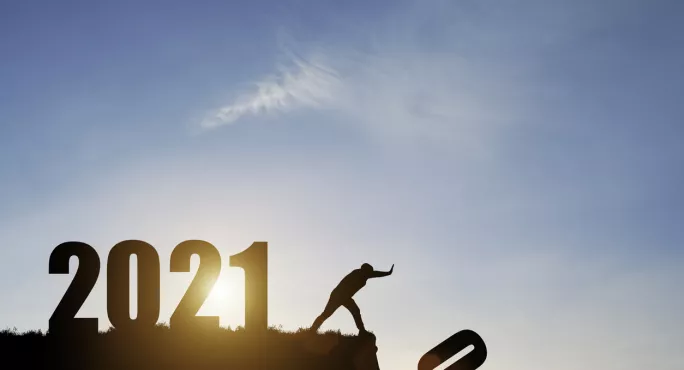
Here’s how to really make a new year’s resolution stick

You want to build a new year’s resolution into your life in 2021? What that requires is for you to develop a new habit - but one you consciously choose.
So let’s go into the brain and see how habits work.
1. Write the code
Imagine your brain is a computer. When you do something for the first time, it has to write a completely new chunk of code to drive the new behaviours and react to the new experiences.
This takes effort and, if there’s one thing we know about the brain, it’s that it will do anything to avoid effort. So, wherever possible, it will use an existing chunk of code - something it can run without really thinking about it.
For example, you have a chunk of code for brushing your teeth, driving a familiar route, and picking up your phone to check for messages. That means we can do all these things in a kind of autopilot.
So, first off, you’re going to have to carry out your New Year’s resolution enough times that your brain knows it has the code ready to go. Whatever the resolution is, it’s much more likely to happen when your brain can slip into autopilot while it’s going on.
But there are two other switches your brain will need to make this work - one to tell it to run the chunk of code and another to make it want to run the code.
2. Clarify the trigger
To take the first of these, you need a trigger - something that makes the brain say “Hey, it must be time to run that chunk of code that handles [insert New Year’s resolution here].”
This means you need to think carefully about what will trigger your resolution. Can you do it first thing, the moment you wake up? Could you do it in the car on your way to work? Maybe you need to set an alarm for some time in the evening?
Whatever it is, just be really clear about the trigger.
3. Focus on the reward
Then there’s the motivation.
What’s in it for your brain to haul out this code and get it running? Where’s the reward? Sometimes rewards are inbuilt, like the endorphin rush of an intense workout or the sense of accomplishment from completing a diary entry.
Other times they may be extrinsic, such as buying a coffee at the end of a walk or getting a guilt-free YouTube session when the marking is done.
As the new behaviour becomes increasingly associated with the reward, just thinking about the behaviour can be enough to generate the reward activity in the brain. This leads to a kind of craving, where you become highly motivated.
Run enough times and these behaviours will be handled by a part of the brain called the basal ganglia - a collection of structures deep within your brain. In fact, people with severe memory loss from brain damage can often still carry out embedded habits, as long as their basal ganglia are not affected.
Sometimes you can use existing triggers and rewards by replacing an existing habit with a new one.
For example, let’s say your New Year’s resolution is to make more of an effort to keep in touch with your friends and family. And you also realise that you drink too much coffee during the day.
Think carefully about what it is that triggers your brain to think of coffee and what the reward is for getting one.
The trigger might be boredom or a need to move around and not feel so sedentary. And the reward might be feeling refreshed or a chance to meet people when you go for a coffee.
Now, use those same triggers and rewards, but switch the routine in between them so that instead of going for a coffee, you get up and phone or text a friend.
4. Use human connection
Think about all the most addictive platforms on social media - Facebook, Instagram, Twitter, WhatsApp, Snapchat, etc. They all have one thing in common: they play on our desire for human connection. This is so powerful that it keeps drawing us back to the app.
New-habit-forming organisations such as Weight Watchers and Alcoholics Anonymous also use this community approach because they know it’s effective So why not use that desire to drive your New Year’s resolution? Make it involve connection with others.
5. Believe
Finally - and perhaps most elusively - you have to really believe that you can change.
As teachers, we’re sometimes better at projecting this onto our students than using it for our own lives. We know the importance of high expectations, and the powerful effect that believing in our students can have on their aspirations and behaviours.
Well, that same rule applies to us. If we want to change something in our own lives, we really do have to believe in ourselves.
Aidan Harvey-Craig is a psychology teacher and student counsellor at an international school in Malawi. His book, 18 Wellbeing Hacks for Students: using psychology’s secrets to survive and thrive, is out now. He tweets @psychologyhack
You need a Tes subscription to read this article
Subscribe now to read this article and get other subscriber-only content:
- Unlimited access to all Tes magazine content
- Exclusive subscriber-only stories
- Award-winning email newsletters
- Unlimited access to all Tes magazine content
- Exclusive subscriber-only stories
- Award-winning email newsletters
You need a subscription to read this article
Subscribe now to read this article and get other subscriber-only content, including:
- Unlimited access to all Tes magazine content
- Exclusive subscriber-only stories
- Award-winning email newsletters
- Unlimited access to all Tes magazine content
- Exclusive subscriber-only stories
- Award-winning email newsletters